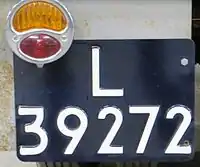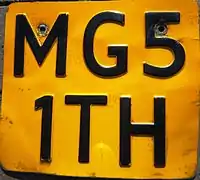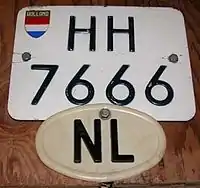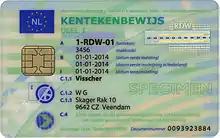Vehicle registration plates of the Netherlands
Vehicle registration plates of the Netherlands are vehicle registration plates issued by the Netherlands Vehicle Authority,[1] RDW.

RDW vehicle registration plates are assigned bearing the same "number" (a sequence of characters composed of letters and digits) as that shown on the vehicle's registration document. The numbering scheme used bears no relation to the place of a vehicle's registration or ownership, and numbers–which are issued in strict time order–identify the vehicle, not its owner. Thus, if a vehicle changes ownership, the registration number remains unchanged.
Earlier schemes
The Netherlands introduced a system of vehicle registration plates on 26 April 1898–the third country in the world to do so, after France in 1893 and Germany in 1896.[2] A plate bearing the number 1 was issued to one J. van Dam, who purchased the first Dutch-built motorcar, which was manufactured at his own Groninger Motor-Rijtuigen Fabriek.[3] Plate numbers stayed with the owner, unlike the present system. From 1906, a new system used the format xx-ddddd, where xx was a province code and ddddd a serial number. This system lasted until 1951, when the current system was introduced.
Province codes

- A: Groningen
- B: Friesland
- D: Drenthe
- E: Overijssel
- G, GZ, GX: Noord Holland
- H, HZ, HX: Zuid Holland
- K: Zeeland
- M: Gelderland
- N: Noord Brabant
- L: Utrecht
- P: Limburg
- R: so-called "Departementen" overseas areas.
Numbering schemes
The current Dutch licence plate system uses black letters on a light-reflecting yellow background, although white reflecting letters on a dark-blue background are allowed for vehicles built prior to 1977. Since 2000, the blue band with the European flag and NL has been mandatory for all vehicles except vehicles built prior to 1977.
Dutch car number plates can be formatted as follows:
| Year | Format | Format (Sidecode) | Comment |
|---|---|---|---|
| 1951–1965 | 1 | This series is currently in use for imported oldtimers (pre-1973), using leftover serial letters not originally issued. The series DE, DH, DL, DM, DR, AE, AH, AL, AM, AR and DZ are used for cars, ZM, ZF and NM for motorcycles and BE for commercial vehicles. | |
| 1965–1973 | 2 | This series is currently in use for special permit vehicles (ZZ). | |
| 1973–1978 | 3 | Yellow plates were first introduced in 1975. These were initially optional but became mandatory from 1st January 1978, a few months before this series ended. This series is currently in use for imported "youngtimers" (1973 - 1977 vehicles), starting with Y (YA, YB, YD currently issued.) | |
| 1978–1991 | 4 | The letters K and Y were used as serial letters in this series.
This series is currently issued to semi-trailers (O). | |
| 1991–1999 | 5 | ||
| 1999–2008 | 6 | In 2000, the Controlled Issuance and Intake of Licence Plates (GAIK; Gecontroleerde Afgave en Inname van Kentekenplaten) licence style started with the F series in this series. All licence plates except some oldtimer registrations were mandated to change to GAIK plates.
This series is currently in use for motorcycles (M) and trailers above 750 kg (W). | |
| 2006–present | 7 | This series is currently issued for heavy goods vehicles (B). | |
| 8 | In this series, the first letters G, H, J, P, and R are not used, as to not clash with former export licence plates.
The letter L is reserved for agricultural vehicles. | ||
| 9 | |||
| 2011–present | 10 | This series is currently issued for private vehicles, starting at G-001-BB. | |
| 2015–present | 11 | This series is currently issued to mopeds (D/F) and to light commercial vehicles (V).[4] | |
| Yet unused | 12 | ||
| 2016–2019 | 13 | This series is currently in use for fast motorboats (Y) and for tractors (0-GV-001 till 9-GV-999) | |
| 2019-present | 14 | This series is currently in use for tractors (001-GV-0 till 999-GV-9) |
Nowadays the letters used do not include vowels, so as to avoid profane or obscene language. To avoid confusion with a zero, the letters C and Q are also omitted. Letters and numbers are issued in strict alphabetical/numeric order. Thus a Dutch licence plate gives an indication of the date of registration of a car, but no information about where in the country the car comes from, or to whom it belongs.
Other formats
With the introduction of the GAIK series, several other formats have been introduced as well. All background colours used are retroreflective.
| Format | Comment | ||
|---|---|---|---|
|
Taxi plates are mandatory since December 2000 for vehicles used to transport people, but aren't part of the public transportation system. | ||
|
Trader plates, used by automotive companies to register current stock under their insurance, these plates are to be used if the car is used for a test-drive and has no insurance on its own licence plate. It is forbidden to park a car on the public road with trader plates fitted. | ||
|
Used for trailers with a maximum weight of less than 750 kg, registration matches the vehicle pulling the trailer. Also used for export, temporary and provisional (single coded, H for 1 month and Z for 1 week) vehicles. |
Recent changes
The licence plates have subtly changed shape in 2002, when not only the letter type (or font) changed, but also a few other changes were made.
- Combatting fraudulent reports of stolen licence plates (giving one three weeks to break speed limits with an alibi), licence plates are replaced immediately but using the same number. The new licence plate is tagged with a small number 1 over the first dash, that is increased with each new plate.
- A blue background is used for taxis.
- White letters on a blue or black background are used for classic cars older than 1 January 1978 and with a registration number in Side Code 1, 2 or 3.
- Black letters on a white background are used for small trailers that hide the car's actual licence plate.
- Large trailers, caravans etc. have now got their own black/yellow licence plate.
- The letter Y is no longer used for cars, but instead for fast motor boats.
- The letter combinations SDB to SDZ and also SSB to SSZ are not issued because 'SD' and 'SS' (and also SA) continue to have fascist connotations in the Netherlands. However, registrations with the letter combination NSB were issued in 2010, although these were recalled because these were the initials of the Nationaal-Socialistische Beweging.[5]
Current series
Motor cars
- 01-DB-BB, registration 1999/2000
- 01-FB-BB, registration 2000
- 01-GB-BB, registration 2000/2001
- 01-HB-BB, registration 2001/2002
- 01-JB-BB, registration 2002
- 01-LB-BB, registration 2002/2003
- 01-NB-BB, registration 2003/2004
- 01-PB-BB, registration 2004/2005
- 01-RB-BB, registration 2005
- 01-SB-BB, registration 2005/2006
- 01-TB-BB, registration 2006/2007
- 01-XB-BB, registration 2007
- 01-ZB-BB, registration 2007/2008 till 75-ZS-KB
- 01-GBB-1, registration 2008 (00 was only used later in the G-series)
- 00-HBB-1, registration 2008/2009
- 00-JBB-1, registration 2009
- 00-KBB-1, registration 2009/2010
- 00-LBB-1, registration 2010
- 00-NBB-1, registration 2010/2011
- 00-PBB-1, registration 2011
- 00-RBB-1, registration 2011
- 00-SBB-1, registration 2011
- 00-TBB-1, registration 2012
- 00-XBB-1, registration 2012
- 00-ZBB-1, registration 2012/2013 till 99-ZXT-1
- 1-KBB-00, registration 2013
- 1-SBB-00, registration 2013
- 1-TBB-00, registration 2013/2014
- 1-XBB-00, registration 2014
- 1-ZBB-00, registration 2014/2015 till 8-ZVK-67
- GB-001-B, registration 2015
- HB-001-B, registration 2015/2016
- JB-001-B, registration 2016
- KB-001-B, registration 2016
- (L was reserved for agricultural vehicles but was not used after the Tweede Kamer voted against a proposal for agricultural licence plates.)
- NB-001-B, registration 2016/2017
- PB-001-B, registration 2017
- RB-001-B, registration 2017/2018
- SB-001-B, registration 2018 (SP only SP-001-B till SP-154-P)
- TB-001-B, registration 2018
- XB-001-B, registration 2018/2019
- ZB-001-B, registration 2019 till ZV-183-Z
- G-001-BB, registration 2019
- H-001-BB, registration 2019/2020
- J-001-BB, registration 2020
- K-001-BB, registration 2020/2021 (current series, now K-PX)
Motorcycles
- MB-01-BB, registration 1979/1998
- MB-BB-01, registration 1998/2011
- 01-MB-BB, registration 2011/2021 (current series, now MN-PZ)
Mopeds
- 01-DBB-1, registration 2005/2006
- 01-FBB-1, registration 2006
- DB-001-B, registration 2006
- FB-001-B, registration 2006/2008
- D-001-BB, registration 2008/2011
- F-001-BB, registration 2011/2015
- DBB-01-B, registration 16 January 2015 till 19 June 2020
- FBB-01-B, registration 19 June 2020 till present day (current series, now FFS-B)
D/FBS-01-D to D/FBS-99-D and D/FBS-01-S to D/FBS-99-S are not used, to avoid SD and SS combinations. Also in the future, D/FxS-01-D to D/FxS-99-D and D/FxS-01-S to D/FxS-99-S (x is the second letter, D till Z) will not be used; and this also for D/FSD-01-B till D/FSD-99-Z and D/FSS-01-B till D/FSS-99-Z for the same reason.
Trucks/Lorries (weighing more than 3.5 tons)
- BB-BB-01, registration 1994/2012
- 00-BBB-1, registration 2012/2021 (current series, now BRH)
Trucks/Lorries (weighing 3.5 tons or less)
- 01-VB-BB, registration 1998/2001
- 01-BB-BB, registration 2001/2006
- 01-VBB-1, registration 2006/2009 (no 00-VSB-1 till 99-VSZ-9)
- 1-VBB-00, registration 2009/2012 (no 1-VVD-00 till 9-VVD-99)
- VB-001-B, registration 2012/2016
- V-001-BB, registration 2016/2019
- VBB-01-B, registration 2019/2021 (current series, now VJH-S)
VBS-01-D to VBS-99-D and VBS-01-S to VBS-99-S are not used, to avoid SD and SS combinations. Also in the future, VxS-01-D to VxS-99-D and VxS-01-S to VxS-99-S (x is the second letter, D till Z) will not be used, for the same reason.
Trailers
- WB-00-01, registration 2000/2008
- 00-WB-01, registration 2000/2008
- 00-01-WB, registration 2000/2008
- WB-01-BB, registration 2000/2008
- WB-BB-01, registration 2000/2008
- 01-WB-BB, registration 2008/2021 (current series, now WZ-FN)
Semi-Trailers
- OB-00-01, registration 1979/1988
- OB-01-BB, registration 1988/2021 (current series, now OS-PK)
And see now also https://groups.io/g/kentekensnieuwsgroep/topic/hierbij_de_maandelijkse/80241396?p=,,,20,0,0,0::recentpostdate%2Fsticky,,,20,2,0,80241396
Special-use licence plates
| Letters | Description | |
|---|---|---|
| B, E, S | .png.webp) | |
| AA | ||
| B, V | The B in the first letter position used to refer to a "Bedrijfswagen" (commercial vehicle): a special status for cars that are exclusively used for commercial purposes. Commercial licence registrations have a separate taxation class, though some 10% of the cars are registered as commercial. A commercial licence is often called "grijs kenteken" (gray registration), referring to the previous colour of the car's registration papers, which is now, like commercial vehicles, green. (XB-??-??), (??-??-XB), (??-XB-??). Above capacity of 3,500 ton (BX-??-XX) till (??-BXX-?). And till capacity of 3,500 ton (VX-??-XX) till (VX-???-X). | |
| BE | Classic commercial vehicles (BE-??-??). | |
| DE, DH, DL, DM, DR, AE, AH, AL, AM, AR, DZ, PM | ||
| YA, YB and YD | Imported classic cars younger than 40 years. (??-YA-??) till (??-YD-??). | |
| KL to KZ & LM, LO, LU, DM | ||
| CD | ||
| CDJ | ||
| BFG | ||
| RC | ||
| M |  | |
| BN or GN | ||
| GV | ||
| HA, HF, HH, FH | ||
| HH |  | |
| ZM, ZF, NM | Secondhands motorbikes. | |
| ZZ |  |
Sidecode 2 is divided in 00-03-ZZ till 03-73-ZZ, 10-00-ZZ and 10-01-ZZ, 20-00-ZZ till 22-30-ZZ Updated 14 June 2019 |
| O | ||
| W | ||
| AF | Used by Allied Forces Northern Europe vehicles. (AF-XX-??) | |
| MM-BS and LBT in side code 8 | Used for cars which have a limited speed 25 or 40 km/h, read https://www.rdw.nl/Particulier/Paginas/Ombouw-voertuig-tot-MMBS.aspx and see also https://www.google.nl/search?q=mm-bs-t5&biw=1600&bih=771&tbm=isch&tbo=u&source=univ&sa=X&sqi=2&ved=0ahUKEwjj4cHXydLNAhVFFMAKHVXQCJMQsAQINw and regarding LBT see https://www.cumela.nl/verkeer-en-vervoer-veilig-landbouwverkeer-voertuigeisen/eerst-kenteken-dan-snelheidsverhoging-naar |
This list is not exhaustive. The Dutch Wikipedia article nl:Nederlands kenteken contains more exceptions.
Vehicle registration

Since January 1, 2014, the Netherlands has an all-plastic vehicle registration in credit card format. This and the driving licence (which is the same size) are the only things needed to bring along while driving in the Netherlands. This registration has the same green appearance for every vehicle category, only the information on the card differs. It has a chip with more detailed information about the vehicle. All previously issued vehicle registrations will remain valid until the car changes ownership, or until the owner requests replacement vehicle registration documents. While a so-called overschrijvingsbewijs (a separate document that came with the vehicle registration) was needed previously to sell the vehicle, this has now been replaced with a code. The registration card and the correct code are enough to sell the vehicle, even without the original letter stating the code as issued during new car registration.
References
- "About RDW". www.rdw.nl. Retrieved 21 November 2017.
- "Geschiedenis van de kentekenplaat". deAutogids.nl. Retrieved 1 April 2009.
- "Groninger Motorrijtuigen Fabriek". deAutogids.nl. Retrieved 1 April 2009.
- Start nieuwe kentekencombinatie lichte bedrijfswagens (dutch)
- "Dutch call back car licence plates with 'Nazi' initials". Daily Telegraph. 2 November 2010.
- http://mpbundels.mindef.nl/11_serie/11_60/11_60_120.htm Archived 24 June 2015 at the Wayback Machine
External links
| Wikimedia Commons has media related to License plates of the Netherlands. |
- Nummerplaat.com, latest news and all information about Dutch Licence Plates
- Information in English RDW, the Netherlands Vehicle Authority
- RDW kentekencheck public vehicle registration data
- Matriculasdelmundo, information, images and pictures of Netherlands licence plates (Spanish)